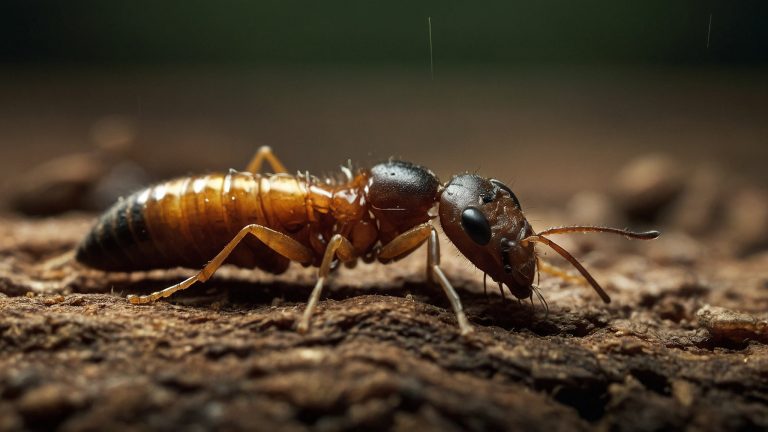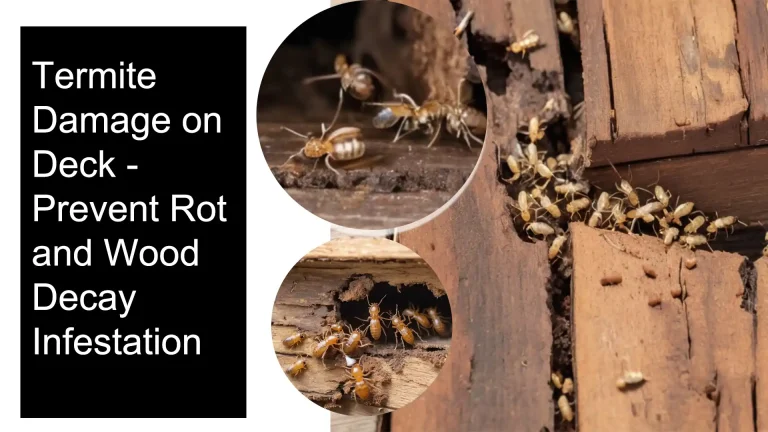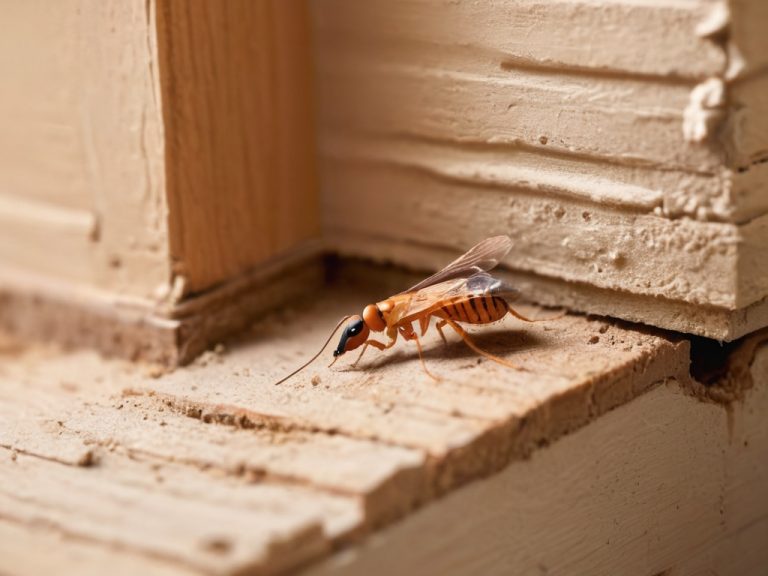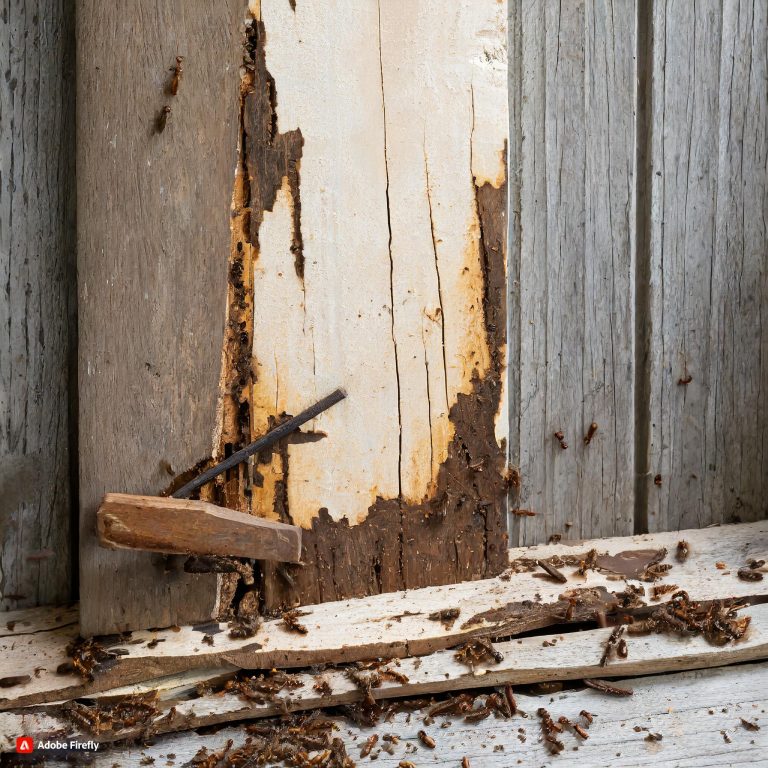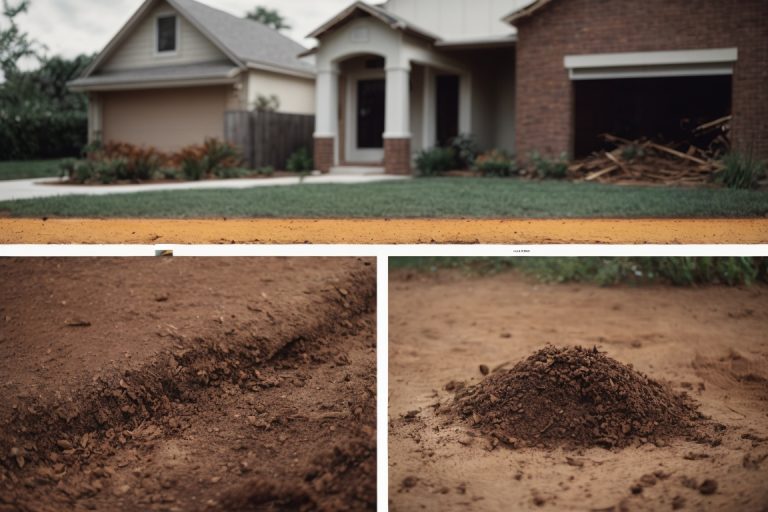How To Tell Old Termite Damage From New? Termite Damage Tips

- Signs of New Termite Damage
- Signs of Old Termite Damage
- How to Tell if Termites Are Active in Your House
- How to Tell Old Termite Damage From New on Doors, Walls and Wood
- What to Do About Old Termite Damage
- How to Tell How Long Termites Have Been There
- How to Know If Termites Are Gone After Treatment
- Active vs Inactive Termite Infestations
- Key Takeaways: Recognizing Old and New Termite Damage
- Conclusion
Termites can cause severe damage to your home if left untreated. But how can you tell whether you have old termite damage or new termite activity? Knowing the signs of new and old termite infestations is crucial for getting effective termite control services before major structural damage occurs.
This guide covers everything you need to know about identifying new and old termite damage. With helpful termite damage photos and descriptions of what to look for, you’ll be able to spot the telltale signs of termites and prevent costly repairs down the road.
Signs of New Termite Damage
Catching new termite damage right away is key to controlling an active termite infestation before it gets out of hand. Here are the most common indicators of new termite activity:
Fresh Mud Tubes and Tunnels
One of the clearest signs of new termite activity is fresh mud tubes snaking across walls, foundations, pillars, and other surfaces. Subterranean termites construct these narrow mud tubes from wood and soil to travel safely from their underground nests to food sources without getting detected.
Within these protective tunnels, you may catch a glimpse of worker termites scurrying around. Cracking open a tube can reveal streams of busy insects and makes it easier to confirm an active infestation. Just be sure to contact a professional pest control company afterwards for thorough termite control services.
While most mud tunnels lead to active infestations, don’t immediately scratch off old dried tunnels either. Termites preserved within still pose a threat if neglected further.
New Exit Holes in Wood
Another warning sign is pencil-thin holes freshly bored into doors, trim, support beams, flooring, furniture, and other wood materials in the home. Drywood and subterranean termites chew out round “kick out holes” in order to access new food sources where they can build nests and tunnels unseen behind walls and under floors.
Discovery of these round holes much narrower than an ink pen indicate termites recently started attacking the area a serious cause for concern. Contact a licensed termite inspector to investigate for current termite activity behind walls where more damage may hide before major repairs become necessary.
Other signs of termite damage like discarded wings or fresh Frass debris around the home also signal new colonies establishing themselves.”
Piles of Sawdust-Like Material
As termites munch through wood from the inside-out, they leave behind powdery debris known as frass. This often collects in small piles beneath exit holes or damaged locations. It resembles grains of sand or hardwood sawdust.
Discovery of loose frass is one definitive sign of active termite infestation. The insects continually go in and out of their tunnels to eat, digest wood particles in their gut, and push out waste. So be sure to test wood in the area and inspect further to gauge the extent of hidden damage requiring termite control measures.
Signs of Old Termite Damage
While finding new termite activity requires swift action, uncovering old damage in a previously treated home generally means you don’t have an active problem anymore. But to prevent future infestations, it’s still important to know what outdated termite damage looks like.
Here are the most common signs you may be dealing with outdated activity:
Crumbling, Damaged Wood
Over time as termites work through wood, their extensive tunnels cause structural wood to become extremely brittle and weak. Pressure from leaning, knocks, and vibrations lead whole sections to crack apart and crumble away. The cracks often run along the wood grain.
It takes years of prolonged feeding for this cumulative internal damage to become visible. So if the infested area is already badly compromised, you can be sure it’s old termite damage. Having wood reinforced or replaced is often necessary in severe cases to prevent collapse, especially in load-bearing walls and support posts.
Weathered Mud Tubes
While fresh mud tunnels mentioned earlier retain shape, color, and house active termites, old neglected tubes fade to grayish white and become dried out, hollow shells without purpose once the colony dies off or relocates. They may crack, flake, or pull off wall surfaces too when knocked.
You’ll know right away it’s outdated damage if a thick layer of dust has built up over the dried path. Simply follow it to check for crumpling wood underneath that may still need replacing behind walls. If no current termite activity exists though, fumigating the whole home is often unnecessary.
Old Exit Holes
In addition to new cleanly-cut exit holes, you may run across outlets with ragged edges. These often appear somewhat faded as weather and time degrade wood further. The jagged bites make sense once lots of termites have come and gone, taking more chunks with them.
Seeing a few enlarged, rough-edged exit holes doesn’t raise as urgent a need for termite control services as new holes which indicate potential issues. But opening up walls to evaluate wood condition is still smart to check for damage possibly requiring repair before future sale or renovations.
How to Tell if Termites Are Active in Your House
Wondering if those worrying signs point to a current termite infestation in your home or just outdated damage? Here are a few key ways to determine if termites are still actively nesting and feeding in your house:
Swarming Termites
The main way homeowners discover a termite attack is by spotting these notorious early springtime swarms. During mating season, developing winged reproductive termites take flight out of infested houses in large groups.
Seeing even one pair of dark termite swarmers with two pairs of nearly equal-size wings crawling near window sills or gathering on walls is an instant giveaway of an active nest. Live insects signal it’s time for professional termite control measure before populations explode.
You also may encounter dropped wings from wherever hordes took off. Since termites discard their wings once grounded, sweeping up 10 or more while investigating means a worrying infestation hides in the home’s woodwork.
Presence of Winged Reproductive Termites
Speaking of wings, catching just one glimpse of winged reproductive termites still scurrying around with wings intact also confirms they started a new colony inside. Don’t let appearances fool you though. Sometimes ant swarmers get mistaken for termites. Ensure you’ve spotted the key termite features like straight antennae and two pairs of equally-sized wings.
Ultimately, finding live termites of any caste signals serious wood-destroying insect activity requiring evaluation and elimination before further spreading or structural damage sets in. Don’t take chances or misidentify the threat.
Termite Droppings
Another definite clue of a recent or ongoing termite concern is noticeable piles of new frass droppings around the home. As insects travel from the nest to damage sites, their waste also trails behind. So follow any sawdust-like debris trails to current problem zones where termites may still reside.
Drywood termite droppings tend to form smaller piles since colonies are slower-growing. Subterranean termite debris builds up quicker though as enormous colonies constantly replace themselves. Either way, fresh fecal dust means termites are presently gnawing through home woodwork undetected.
How to Tell Old Termite Damage From New on Doors, Walls and Wood
When evaluating the extent of a termite infestation in various locations, it helps to know exactly how new and old damage differ visually across affected materials like doors, walls, support beams and flooring.
Here are tips on identifying active or outdated termite damage in some of the most vulnerable home infrastructure:
On Doors
One very noticeable place to discover termite damage is wooden door frames and panels. New attacks first show tiny popped exit holes scattered about. As they multiply, expect to see trails of powdery frass running along the base and leading inside hollowed pockets within doors. Sagging becomes visible in time once termites have severely compromised the inner structure.
In comparison, an old inactive problem would reveal no new holes, only large ragged exit points all in one contained area. Nearby walls may have connecting mud tunnels running to the static infestation site too. The door itself probably sags heavily by now and sections of the frame crumble from the deep erosion over time.
On Walls
On walls, very recent invasions first damage unseen wooden components like insulation, beams, wiring and panelling behind layers of drywall or siding. Until the colony grows large enough, there may be little outer evidence. Homeowners only suspect trouble from hearing soft thuds of termites occasionally bumping their heads.
Later, small exploratory mud tubes start to appear sneaking upwards from the ground and popping kickout holes release trapped termites. Inside hollowed channels also echo a “tapping” noise from active movement. Intense scrutiny then reveals trails of powdery frass seeking new routes behind walls where major unseen destruction often lurks.
For inactive former problems though, you would spot thick tubes running along several feet of walls left from previous hunts. Knocking on multiple areas sounds firmly hollow from extensive tunnelling over time. No new outlets pop anymore. Any live insects likely relocated away already from the barren sections leaving only lasting residue of sagging drywall and underlying wooden lattice in poor condition.
On Wood
On exposed wood like posts, rafters and timbers, bright new termite damage makes itself known through networks of dime-sized holes scattered about instead of in concentrated areas. The spots sound doughy when tapped vs solid. Paint may also bubble up from unseen activity underneath. Active tunnels packed with termites branch out from the nest behind compromised zones.
Whereas with older extinct damage, wood appears deeply pitted by large gaps up to several inches wide surrounded by dried runoff trails. Weak grooves wander along with the wood grain. Knocking elicits a completely hollow noise or even splits decrepit beams. No new holes multiply since the infestation died off though lingering tunnels may run beneath shattered zones.
What to Do About Old Termite Damage
If the colony has died or relocated, it is not necessary to tent or treat your home if you discover old termite damage. However, further measures should be taken to assess the extent of damage in order to prevent pests from returning.
Here are smart tips if faced with resolved cases of prior termite destruction around the home:
- Inspect wood integrity in the damaged areas and test for current activity. Look for live insects, fresh holes, and hollow spots. Knock on wood to check for soundness. See where trails lead.
- Probe with an awl around exit holes and under damaged exterior coating to gauge the depth of tunnels and reveal hidden weak points. Look for moisture or standing water sources.
- Monitor identified damage sites for any signs of new termite colonies attempting to move in like fresh mud tubes or additional screw holes.
- For crumbling infrastructure like walls, molding, and critical supports, have a contractor reinforce compromised wood with epoxy, fillers, or extra framing for safety, restore aesthetics around impact zones, and ensure proper drainage exists.
- Consult a pest management professional to apply targeted spot treatments or baits if concerned about repeat occurrences in previously habituated areas. But extensive fumigation is often unnecessary for resolved old damage without current activity.
- Address conditions that made your home susceptible before, like moisture sources, foam insulation, wood debris and soil contact. Divert downspouts, improve ventilation, eliminate conducive conditions, and layer protection like sand barriers and concrete.
How to Tell How Long Termites Have Been There
Are you dealing with a long-standing multi-year termite infestation or fresh new attack? Evaluating the depth of damage serves as the number one clue for gauging the rough duration termites have resided and fed on your home.
Here’s what to look for:
- Active vs inactive signs: again you want to check for live swarmers, new holes and mud tube formation vs outdated hollow tunnels signaling resolved damage from some past untreated invasion.
- Multiplications of holes/tubes: seeing strings of exit holes in a line means a colony has followed and tunneled extensively through a structure vs more sporadic pinpricks from newcomers.
- Penetration depth of holes/tubes: shallow penetration and shorter isolated tubes indicate a newer starter colony while deep elaborately branching mud highways full of cross routes reflect a mature long-embedded colony understanding the home terrain all too well!
- Severity of interior wood damage: Minor surface nibbling, soft spots and a few tunneled trails signify fresh attacks before mass timber defoliation happens in the late-stages of a longstanding siege.
As a general rule, The longer termites are able to destroy, the bigger the exit holes, the deeper the tunnels, and the more fragile the inner wood becomes.
How to Know If Termites Are Gone After Treatment
Do you wonder if the termites that have been infesting your home survived the chemical treatment or the high-heat tenting method? Ask these questions to ensure your home was cleared completely.
Were effective monitoring devices installed?
After treatment, reputable pest control companies will install termite detectors in and around your home. Baited stations are inserted in the ground and filled with food that attracts worker termites searching for the old colony. The sensors capture any pests crawling on the surface and identify them for further identification.
Did the post-treatment inspection find termites?
A thorough pest specialist will return for inspection 60-90 days after initial services to check monitoring devices, reassess areas of past damage, test wood integrity and make sure all pests are gone before issuing clearance notices. If they missed anything, a more targeted removal would be performed.
Have there been any swarmers or signs of new damage?
It is important to check on your own that the swarming did not occur again in subsequent years, when warmer weather returns. Double check that in the spring, no new mud holes or tunnels have appeared. This could indicate a treatment failure. If you see the same issues, colony survivors are still there!
How does my moisture and drainage situation look?
As part of your plan for protection, you should improve the home environment that allowed infestations to occur. Make sure downspouts are properly directed away from buildings. If you pile up debris near your home, termites will find it easy to settle in the moist, shady areas around your house. This is a sure sign that they’ll come back and test out your foundation someday.
Active vs Inactive Termite Infestations
What’s the difference between an active vs inactive termite invasion? Homeowners can take control measures based on the current level of activity in their home by knowing key signs. Below are the main contrasts:
- Live sightings of winged swarmers emerging indoors or collecting on walls
- New pencil-sized mud tubes forming on walls, pillars or concrete areas
- Pinprick holes multiplying as termites investigate new nesting wood sources
- Fine dusty piles of termite dropping accumulation by damaged locations
- Wood in affected areas sounds hollow and damaged if probed further
- Noticeable crumbling of structural wood over time
Inactive Termite Infestation
- No witness of live termite swarmers for a few years
- Old abandoned mud tunnels remain visible but don’t multiply
- No new holes emerging really though old large outlets still prominent against walls or wood fixtures
- No new frass piles gather anywhere
- Knocking on walls elicits solid dull sounds without resonance
- Past wood damage remains contained without spread or collapse
Seeing active signs always warrants immediate inspection and elimination services before the attacks intensify further. Verify you have spotted key traits like two pairs of wings and straight antennae vs other wood-destroying insects that may blister and discard wings similarly. Inactive damage generally means old died off colonies but keeping up diligent monitoring and moisture control helps avoid new colonies sensing easy food sources in your already vulnerable home!
There are different types of termites like subterranean, drywood, dampwood and more. An experienced pest control service provider can tell the difference between the species through proper inspection to determine the optimal treatment method.
Key Takeaways: Recognizing Old and New Termite Damage
- Fresh mud tubes with live insects signal new hidden damage requiring immediate pest control response.
- Pencil-sized exit holes in expanding numbers likely indicate a new attack.
- Old tunnels get bleached by sun and abandoned by dead colonies but still require remediation repairs in the long run.
- If the damaged area sounds completely hollow and splits apart easily, termites have likely been feeding there for years.
- Ultimately once you spot any potential indicators—new or old—inspection should follow to gauge next steps! Prevention starts by knowing what to look for!
Conclusion
It is important to be able to distinguish between old and new termite damage. This will allow you to respond more quickly to threats that are active before they compromise your home’s inner structure. Inspection of old areas can still help assess the impact on safety and integrity, even if previous colonies have died.
Be on the lookout for early warning signs such as fresh mud tracks with termites in them, new holes of a pencil size appearing in unfamiliar areas, and dust particles around infested areas. These warrant immediate professional termite control services.
Understand that damage which appears to be exponential is actually the result of years of unchecked activity. In these areas, seek structural repairs. The lack of live sightings suggests that prior problems have already been resolved naturally, so fumigating might not be necessary!
This guide will help you to protect your home by implementing proactive monitoring, taking swift action when alarming signs appear, and deterring further invasions.

